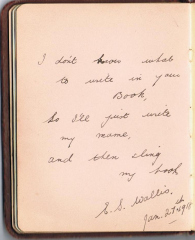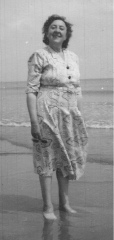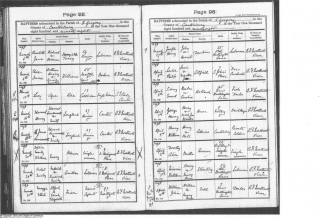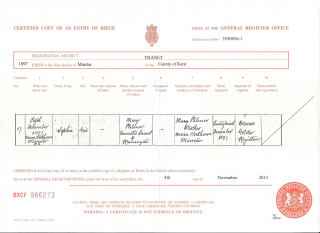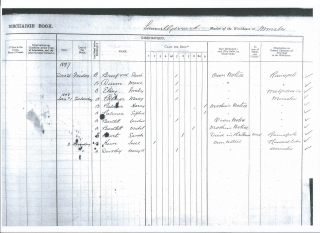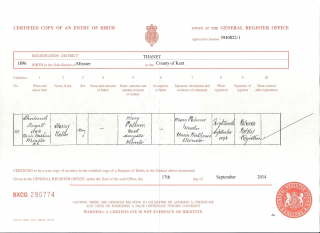Emily Wallis and Helen Lucy (Nell) Emptage were friends and on 21st July 1917, Emily was a witness at Nell’s marriage to Henry Davis Wright, at the church of St Gregory the Great, Canterbury.
A few months later, Helen’s brother Edward Lindsey Emptage married Jessie Simmons in Kent.
There was a family and friends gathering in Canterbury on 27 January 1918 and Emily wrote in Jessie’s autograph book, signing it E.S. Wallis.
[The autograph book is in the possession of David Emptage, Edward Lindsey’s son by his second wife.]
So clearly, Emily knew the Emptage family before she married Nell’s younger brother Walter in 1920.
Emily Sophia Wallis and Walter Dansy Emptage were married on 31st May 1920. Walter was 24, a bachelor, a civil service clerk, ex army. Emily was 22, a spinster, no occupation given. They were both living at 10 Mill Lane, Canterbury. Emily’s father was given as James Wallis, deceased tanner. One of the witnesses was Emma Wallis.
Emily’s father, James had died in 1919 but her mother, Emma, was still alive and they set up home in the same house with Emma. She died in 1936, aged 65.
Emily was already pregnant when they married and between 1920 and 1939, Emily and Walter had twelve children: Joan, Eileen, James (who sadly died within two years), Allan, Hazel, Ena, Stella and Brenda (twins), Anthony, John, Jill and Colin.
War broke out within weeks of Colin’s birth. Canterbury was not safe for a family during the second World War. My cousin Julia, daughter of Hazel, remembers her mother saying that she and her brother Alan had leant out of the upstairs windows to watch the ‘dog fights’ taking place in the skies above them. She thinks that the house had been damaged at some stage.
Some of the children were evacuated, with two going to one place and two to another, leaving the youngest children with their mother.
Anxious to have the family back together, Emily made the decision to move to Yorkshire, where it is thought that Walter’s regiment was stationed.
Joan and Eileen, the two eldest children, who were 17 and 19 and already working, remained in Canterbury but the rest of the family moved to Yorkshire and remained there after the war ended.
Emily died in Yorkshire in 1961, aged 62. Her death was registered as Sophia E Emptage.
So what do we know of Emily before she married?
The Censuses
In 1911, Emily and her parents were living at 10 Mill Lane, Canterbury.
James M. Wallis was aged 40, married, a tanner, born in Colchester, Essex. His wife was Emma Wallis, aged 35, a domestic charwoman, born in Canterbury. The census shows they had been married 16 years, and had 1 child born alive, who was still living. Their daughter was Emily Sophia Wallis, aged 13, born in Canterbury.
So Emma Wallis, who was a witness at the marriage of Walter and Emily in 1920, was Emily’s mother. And when they married they were living with her, at her home at 10 Mill Lane.
The 1901 census lists Emily as the three year old daughter of James and Emma Wallis, living at 9 St Radigund Place, Canterbury. James was a tanner and Emma was a charwoman.
Birth and Baptism
Having found Emily aged just three in 1901, it was time to look for a birth record in or around 1898 but I couldn’t find one for either Emily Sophia Wallis or Sophia Emily Wallis any time between 1896 and 1899. So I looked for any Emily Sophia or Sophia Emily born in those years and found three. Two had died before 1901 and the other was with her family in 1901.
I remember my mother saying that Emily was adopted and this seems to be born out by the fact that there is no suitable birth record for an Emily Sophia or Sophia Emily Wallis.
Until it became regulated in the early twentieth century, adoption was a private and informal matter. Some adoptions were arranged through the church but many were between families and friends and others arranged through doctors and midwives.
So James and Emma’s adoption of Emily would have been a private matter and the chances of finding any records and therefore her birth family and ancestors were remote. Indeed, some members of the family thought that Emily had originally come from France (although this was never mentioned by my mother). If Emily was from France, it would make the records even more difficult to trace.
And there the matter of Emily’s origins rested until, in October 2013, I was contacted by Team Emptage member, Joan Leary.
She had read the story I had published on the original website and had wondered about Emily. Joan began looking through the baptismal parish registers for Canterbury, which had become available on the internet since I first wrote the story.
Joan searched the years around 1897/98, which would fit with Emily being aged three at the time of the 1901 census and found an entry in the register for St Gregory’s Church, Canterbury.
Sophia Emily Wallace Palmer was baptised on the 20th March 1898.
Her mother’s name was Mary Palmer, living at 9 St Radigund’s Place, Canterbury and she was noted as a single woman.
So, in 1898, Mary Palmer and Sophia Emily Wallace Palmer were living at 9 St Radigund Place, the exact same address where James, Emma and Emily Wallis were living in 1901.
Evidently we cannot determine the exact circumstances but, quite possibly, James and Emma Wallis were living there in 1898 when they acquired a lodger, a single lady who had recently had a baby.
James Wallis and Emma Lawson married in April 1895. By 1898, it may have seemed that Emma couldn’t have children and so they decided to adopt the baby.
Thus, when baby Sophia Palmer was baptised, she was given two additional names and became Sophia Emily Wallace Palmer.
I imagine that Emily was chosen as being close to her intended adopted mother’s name of Emma, and that Wallace was added as an indication of her intended adopted family name.
As it appears the decision had already been made to adopt the baby, we might wonder why she was not simply baptised Emily Sophia Wallis but perhaps the vicar was a stickler for correctness and knew that the baby wasn’t Emma’s natural daughter.
[In those days, the names Wallis and Wallace would have been spelt simply as people heard them or as they already knew them, so the vicar probably wouldn’t have thought to ask how to spell Wallis/Wallace.]
However, there is another consideration. Single women couldn’t register the baby in the father’s name unless he was present at the registration and gave permission. And, of course, many men refused to acknowledge the baby. So, at registration, many women then added the father’s surname as a middle name, whether in defiance or trying to give the child a clue about their parentage.
Of course, we don’t know if the addition of the name Wallace to Sophia’s name at the time of her baptism was due to James being the baby’s natural father or because Mary Palmer knew the baby was going to be adopted by James and Emma Wallis.
Assuming that Sophia Emily Wallace Palmer wasn’t very old when she was baptised in March 1898, I looked for a birth record.
Sophia Palmer was born on 5 December 1897 at the Union Workhouse, Minster, Isle of Thanet. No middle names were given.
Her mother was Mary Palmer, a domestic servant in Ramsgate. The space for the father’s name was left blank, indicating illegitimacy.
As the name Wallis wasn’t added as a middle name at the time of registration, I’m inclined to discount the theory that James may have been Sophia’s natural father.
For some women, entering the workhouse as unmarried mothers, especially if they didn’t have a home or job to go back to after the baby was born, meant that they had to stay at the workhouse, working in the kitchen or laundry, with their baby being taken from them after just a few weeks, to be brought up in the children’s home part of the workhouse and rarely visited.
However, Mary Palmer was evidently resourceful. Sometime between 5 December 1897 and 20 March 1898 she and her baby arrived at 9 Radigund Place, Canterbury. And the rest, as they say, is history.
Some time between her baptism in March 1898 and the 1901 census, Sophia Emily Wallace Palmer was adopted by James and Emma Wallis and became Emily Sophia Wallis.
James and Emma Wallis
It is said that Emily complained that she had a hard childhood because her parents were old and they were strict. When Emily came into their lives, James was aged 30 and Emma was 27, neither of which seem old to me, but perhaps they were several years older than the parents of Emily’s friends. And perhaps, being an ex soldier, James was strict. So it is possible that Emily did have a hard childhood.
But, as shown by the story of Frank Sidney Smith, who was not only born in the Thanet Union Workhouse at Minster but whose mother Minnie Clara Smith, nee Emptage, was born there just seven months after Sophia Palmer and who spent most of her life there, Sophia was extremely lucky to have been adopted by James and Emma Wallis and become Emily Sophia Wallis.
James Wallis was from Colchester, Essex, which is a garrison town. He enlisted in the 3rd Essex Militia Regiment in October 1886 and transferred to the 19th Hussars in October 1887. James was stationed in the East Indies from September 1891 to December 1893 where he sustained an inguinal hernia and was sent back to England for discharge, arriving in Canterbury (also a garrison town) in December 1893. James served in the reserves until October 1899 when his discharge was signed by the commanding officer of the 2nd Calvary Brigade, Canterbury.
James met Emma Lawson when he was stationed in Canterbury. She followed him back to Colchester where they married in 1895 but by the time of his discharge from the reserves they were living in Canterbury, Emma’s home town.
Mary Palmer
Having discovered the birth of Sophia Palmer in the Thanet Union Workhouse, Minster, we found the relevant entries for Mary Palmer and Sophia in the workhouse registers.
Mary Palmer was admitted on Friday 22 October 1897, from Minster (the local village). Her year of birth was given as 1872. The birth of Sophia Palmer was recorded on Sunday 5 December 1897.
However, it seems that Mary’s admission on the 22 October was not her first admission, for she had been discharged to Minster the day before, by her own notice. Evidently she returned after just one day. What could have led to her leaving the workhouse for just one day? Did she have arrangements to make?
Well yes, it seems so.
On 3 November 1897, Mary’s son Henry Walter Palmer was admitted, from Minster. He was noted as born in 1896.
Nearly two months later, on 1 January 1898, Mary Palmer, her son Harry and her daughter Sophia were all discharged from the workhouse, at Mary’s notice, to Minster.
What happened between then and 20 March 1898, when Mary and Sophia (with or without Harry) were at 9 St Radigund Place, Canterbury and Sophia was baptised Sophia Emily Wallace Palmer, is unknown.
Unless there is a clue in the workhouse records, we’re unlikely to find out whether or not Mary already knew either James or Emma Wallis before she moved to 9 St Radigund Place.
Emma and Mary may already have been friends so, knowing that Emma couldn’t have children, they arranged that Emma would adopt Mary’s baby.
Or, perhaps, Mary was simply a lodger who found herself in the right place for her baby to find adoptive parents.
What happened to Mary Palmer? Did she remain in Canterbury?
And what about Sophia’s brother, Harry? Was he a full brother or a half brother?
The birth certificate shows that he was named Harry Walter, born on 13 August 1896 and that, like his sister Sophia, he was also born in the Union Workhouse. Mary was given as the mother, a cook domestic of Minster. There was no father’s name.
Although he left the workhouse with his mother on 1 January 1898, Harry was back there by the census on 31 March 1901. He was aged four years and seven months and he was on his own. There was no sign of his mother Mary.
Children were allowed to stay in the workhouse until they were 14. Harry would have been fourteen in August 1910, eight months before the 1911 census. He was not at the workhouse at the time of the census and I think it highly unlikely that he was adopted after the age of four.
And thus it is that, no matter how old her parents seemed, and how strict they were, I think Emily probably had an easier life than the little boy left alone in the Thanet Union Workhouse.
Further research of the workhouse registers will tell us the name of the town or village to where Harry was discharged, but extensive research would be needed to comb through the other workhouse papers, for Mary’s admission for both births, to see if there is any more information about her or her children. However, the surviving records for Thanet Union Workhouse do not appear to be as comprehensive as for other workhouses and so it may be that there is nothing left to discover apart from the admission and discharge registers.
Unfortunately, the names Mary Palmer and Harry Palmer were common ones and, despite many hours searching, even with her 1872 year of birth, it is impossible to identify Mary in the 1901 or 1911 censuses. Of course, she was just 25 or 26 when her daughter was born, so she may have married by 1901. I have checked the 1911 census for every Harry Palmer born between 1895 and 1897 and cannot find one born in Kent, let alone Thanet.
At the time of writing this, I have been researching family history for eleven years (for my own family and for clients) and, like all family historians, have experienced highs and lows in that time. I have been both shocked and saddened by some of the things which I have uncovered.
I found the discovery of Harry particularly upsetting and it has taken me some time to be able to write this chapter in our history.
I can’t help wondering what happened to him in the 1914-18 war which broke out when he was just 18.
And wondering if Emily was ever told that she had a brother.
All told, from the excitement of finding Emily’s baptism and the birth of Sophia, it has become another sad story of the time, with unmarried mothers and children born in the workhouse. But unlike so many others, Emily was lucky to escape and to be adopted though, of course, she would not have realised her good fortune.
Susan Morris
1 October 2015
